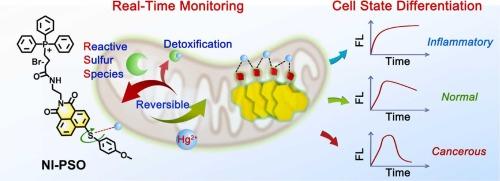A Reversible Aggregation-Induced Emission Fluorescent Probe for Dynamic Visualization of Intracellular Mercury(II) and Cell State Differentiation
IF 12.2
1区 环境科学与生态学
Q1 ENGINEERING, ENVIRONMENTAL
引用次数: 0
Abstract
The dynamic interplay between toxic mercury ions (Hg2+) and reactive sulfur species (RSS) in living systems plays a crucial role in cellular defense mechanisms and redox homeostasis. However, current fluorescent probes for Hg2+ are limited by their irreversibility and inability to provide the real-time information. Herein, we present a novel reversible aggregation-induced emission (AIE) fluorescent probe, NI-PSO, that overcomes these limitations. NI-PSO exhibits a remarkable 160-fold fluorescence enhancement upon Hg2+ binding with high sensitivity and selectivity. The probe’s unique reversibility, facilitated by the coordination interaction between phenylthioether and Hg2+, enables real-time monitoring of mitochondrial Hg2+ in the presence of exogenous and endogenous RSS. Notably, by visualizing Hg2+ dynamics, NI-PSO successfully differentiates various cellular states, including normal, inflammatory, and cancerous cells, providing insights into the role of RSS in mercury detoxification and maintaining cellular redox homeostasis. Our design opens up new avenues for investigating dynamic biological processes and their implications in health and disease.

求助全文
约1分钟内获得全文
求助全文
来源期刊

Journal of Hazardous Materials
工程技术-工程:环境
CiteScore
25.40
自引率
5.90%
发文量
3059
审稿时长
58 days
期刊介绍:
The Journal of Hazardous Materials serves as a global platform for promoting cutting-edge research in the field of Environmental Science and Engineering. Our publication features a wide range of articles, including full-length research papers, review articles, and perspectives, with the aim of enhancing our understanding of the dangers and risks associated with various materials concerning public health and the environment. It is important to note that the term "environmental contaminants" refers specifically to substances that pose hazardous effects through contamination, while excluding those that do not have such impacts on the environment or human health. Moreover, we emphasize the distinction between wastes and hazardous materials in order to provide further clarity on the scope of the journal. We have a keen interest in exploring specific compounds and microbial agents that have adverse effects on the environment.
 求助内容:
求助内容: 应助结果提醒方式:
应助结果提醒方式:


